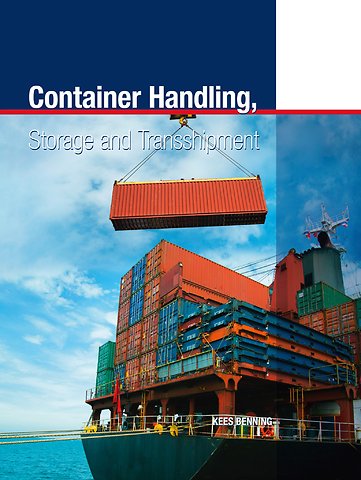

Kees Benning studeerde geografie en logistiek management en is docent en programmacoördinator aan het Scheepvaart en Transport College in Rotterdam, Nederland.
Meer over Kees BenningContainer Handling, Storage and Transshipment
Paperback Engels 2020 1e druk 9789492083227Samenvatting
Container Handling, Storage and Transshipment is a unique and complete handbook about containers. It discusses various aspects of containers, such as types of containers, wind forces, tools and, of course, safety.
In addition the book pays attention to storage and transshipment.
Container Handling, Storage and Transshipment combines theory and practice, which makes it suitable for those who work in a port or container terminal or students in port and terminal management.
Specificaties
Lezersrecensies
Inhoudsopgave
U kunt van deze inhoudsopgave een PDF downloaden
1.1 History
1.2 Malcom McLean
1.3 Sea land service
1.4 Developments in container shipping
The container
2.1 Containers
2.2 ISO
2.3 Dimensions and weights in accordance with ISO 668
2.4 Non-standard dimensions
2.5 Weight
2.6 Corner castings / corner fittings
2.7 Provisions for forklift trucks and other supplementary provisions
2.8 Codes and numbers
2.9 Check digit
2.10 Country code
2.11 Dimensions and type
2.12 Type of container
2.14 Identification
Container structure
3.1 Structure
3.2 Sides
3.3 Other information on containers
3.4 Structure
3.5 End and side walls
3.6 Materials
3.7 Steel containers
3.8 Plywood/ RFP containers
3.9 Aluminium containers
Safe containers
4.1 Tests
4.2 Stacking test
4.3 Lifting test
4.4 Restraint (longitudinal) test
4.5 Strength of end walls test
4.6 Strength of side walls test
4.7 Strength of rooftest
4.8 Strength of floortest
4.9 Rigidity test
4.10 Lifting from fork-lift pockets test
4.11 Lifting with grappler arm test
4.12 Weatherproofness
4.13 Requirements
Types of containers
5.1 General
5.2 Groups of containers
5.3 ISO classification
5.4 General purpose container (00 through 09 or G)
5.5 Ventilated container (10 through 19 or V)
5.6 Thermal containers
5.7 Open container (50 through 59 or U)
5.8 Open container (60 through 69 or P)
5.9 Tank container (70 through 79 or T)
5.10 Special container (80 through 89 or B)
5.11 Air freight container (90 through 99)
Temperature controlled containers
6.1 General
6.2 What else can reefers do?
6.3 Pre-trip inspection (PTI) of reefers
6.4 Power supply
6.5 Temperature
Stowing, stacking and securing
7.1 Stowing
7.2 Stacking
7.3 Securing
7.4 Developments in securing containers
7.5 Safety and damage prevention
7.6 Carefulness
Static and dynamic forces
8.1 Forces
8.2 Various forces
8.3 Vessel movements
8.4 Forces acting on a container
8.5 Transport bij inland waterway vessel
8.6 Transport by rail
8.7 Transport by road
Wind forces
9.1 Beaufort scale
9.2 Formula
9.3 At an angle
9.4 Container terminal
9.5 Formula
9.6 Tension of lashings
9.7 Waves washing over containers
Securing containers (I)
10.1 Forces
10.2 Horizontal displacement
10.3 Vertical displacement
10.4 Fully automatic twistlock
Securing containers (II)
11.1 Bridge fittings
11.2 Lashing materials
11.3 Links
Container handling
12.1 Container handling equipment
12.2 Dockside container crane
12.3 Container gantry crane
12.4 Straddle carrier
12.5 Mobile crane
12.6 Forklift truck
12.7 Reach stacker
12.8 Storage and transshipment
12.9 Tractor with trailer
12.10 Transfer crane
12.11 AGV
12.11 LAGV
12.13 ASC
Storage and transshipment handling equipment engineering
13.1 Parts
13.2 Multi-purpose container crane
13.3 Container gantry crane
13.4 Rubber tyred gantry crane
13.5 Straddle carrier
13.6 Ancillary equipment
Attaching containers
14.1 Attaching loaded and empty containers
14.2 Attaching/lifting loaded containers
14.3 Attaching/lifting empty containers
14.5 Statutory provisions
Outgoing containers by seagoing vessel
15.1 Liner shipping
15.2 Shipowning company
15.3 Freight broker
15.4 Bay plan
15.5 Bill of lading
15.6 Manifest
Incoming containers by seagoing vessel
16.1 Incoming cargo
16.2 Endorsement
16.3 Release order
16.4 Release and delivery of containers
16.5 Carrier
16.6 Detention (container rent)
16.7 Demurrage (container rent plus container yard rent)
Identification of the position of containers at container terminals and on container ships
17.1 Identification of position on a map
17.2 Chessboard
17.3 Container terminal
17.4 Container ships
17.5 Other numbering
17.6 Tier
17.7 Identification of bay, row and tier position and the loading/unloading plan
17.8 Loading/unloading plan
17.9 Communications
Container terminal security/safety
18.1 ISPS code
18.2 Security levels
18.3 Safety at the terminal
18.4 Traffic regulations
References
Index
Rubrieken
- advisering
- algemeen management
- coaching en trainen
- communicatie en media
- economie
- financieel management
- inkoop en logistiek
- internet en social media
- it-management / ict
- juridisch
- leiderschap
- marketing
- mens en maatschappij
- non-profit
- ondernemen
- organisatiekunde
- personal finance
- personeelsmanagement
- persoonlijke effectiviteit
- projectmanagement
- psychologie
- reclame en verkoop
- strategisch management
- verandermanagement
- werk en loopbaan